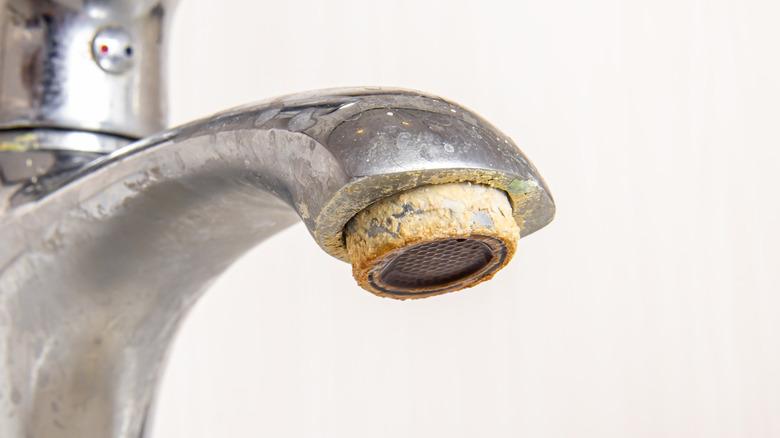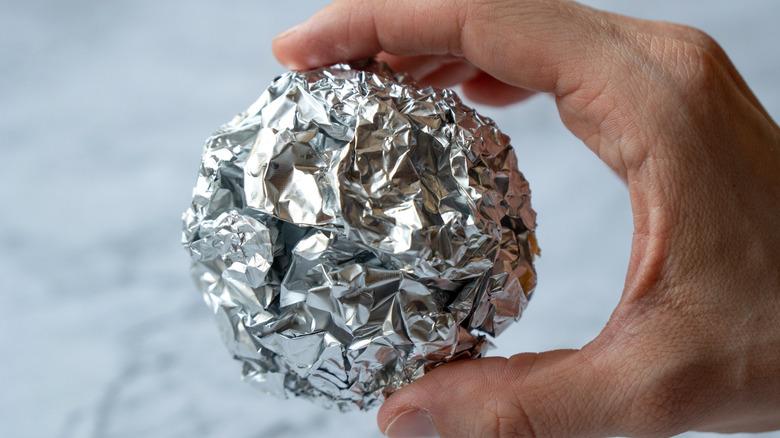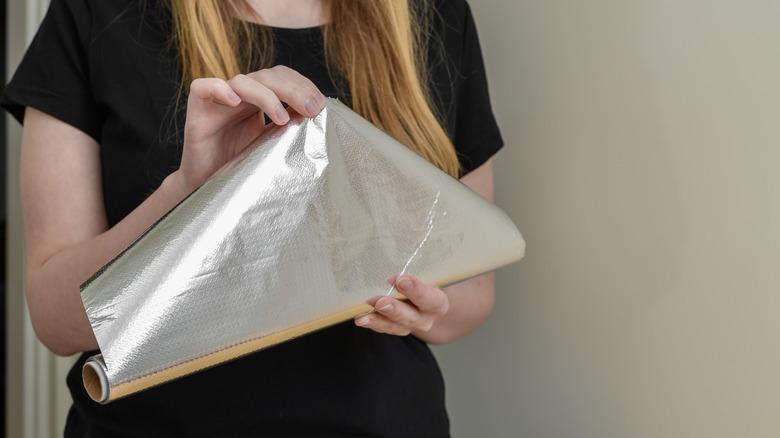Eliminating Hard Water Stains Is A Breeze With A Handy Aluminum Foil Trick
The majority of people in the U.S. have to deal with hard water, so unless you're part of a small minority or have been blessed by the plumbing and water-softening fairies, hard water stains happen. They can occur anywhere that produces water, like sinks, showers, and toilets. Removing them can be extremely difficult, especially if they have been building up for a long time, resulting in hard mineral deposits known as limescale, even if you use products specially formulated to remove hard water stains. There are lots of genius aluminum foil hacks out there, but one of our favorites is using foil to remove hard water stains from a number of surfaces, such as stainless steel, chrome, and other hard metals.
Aluminum works to break down these stains in a few different ways. First, when crumpled into a ball, aluminum foil can be used as a gentle but effective abrasive tool, similar to a scrub brush. Secondly, when aluminum foil comes in contact with other metals of different electrochemical levels, a phenomenon known as galvanic corrosion occurs. The foil becomes reactive and can chemically, as well as physically, break down the hard water stains. This effect only takes place with water and is enhanced with the help of an electrolyte solution such as salt or vinegar, which creates a conductive path between the two metals. This is the chemical reaction that makes foil so good at eliminating hard water stains. We'll walk you through how to use it in your home.
How to use aluminum foil to remove stains from surfaces
First, let's talk about which surfaces you will want to use this method on. Basically, you can use foil on hard metal surfaces like stainless steel, chrome, iron, and so on, in order to get the galvanic corrosion effect. You'll commonly find these finishes on plumbing faucets and kitchen sinks, all of which are highly susceptible to hard water stains. These surfaces are hard enough that the foil won't scratch them. To get started cleaning, take a big sheet of aluminum foil and then squash it into a crumpled-up ball. It doesn't need to be perfect, and in fact, the crinkly ridges will make cleaning easier as they create more friction. Then, create a mixture of water and either sea salt, lemon juice, or vinegar in a bowl or spray bottle. Apply this solution directly to the aluminum foil and start brushing in gentle circular patterns on the surface.
The stains should start to lift almost immediately, and you may notice your foil ball becoming discolored as it takes on the corrosive damage. Just like a sponge, your foil ball will become tired and unable to clean effectively, so you may need to start a new ball if you're cleaning multiple surfaces with significant hard water buildup.
Can you use foil on other surfaces?
One of the popular dishwasher hacks we've seen is putting a crumpled piece of foil in the dishwasher to leave dishes looking sparkly clean. Some say it can even impact non-metal dishware such as drinking glasses and coffee mugs, but is that really true? Aluminum foil can be helpful for one purpose in the dishwasher: in the utensil caddy. When bunched up in the caddy, foil is able to cause galvanized corrosion on silverware, which is also very prone to becoming cloudy with hard water. Many swear that this leaves their everyday silverware looking shiny and good as new, and that seems to hold up. However, the foil wouldn't be able to reach, say, glasses on the top shelf, so it wouldn't offer any physical cleaning capabilities, and because they aren't made of metal, they won't provide a chemical reaction, either.
You may also be tempted to use aluminum foil on other hard water-prone surfaces like shower glass doors. Foil may be helpful as an abrasive in these areas, but it can also cause damage by peeling up glass tints or leaving behind streaks. Instead, stick to other hard water removing solutions for all other surfaces.


